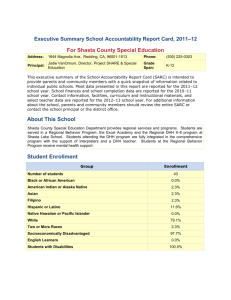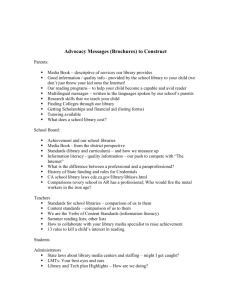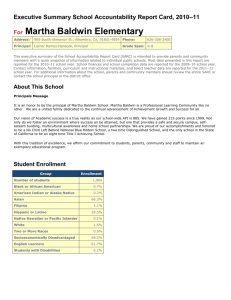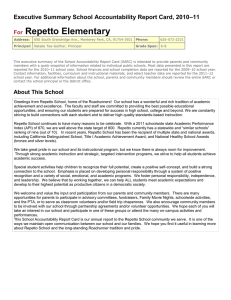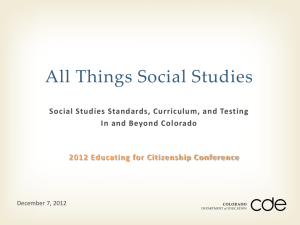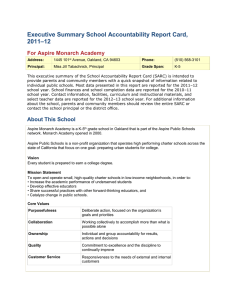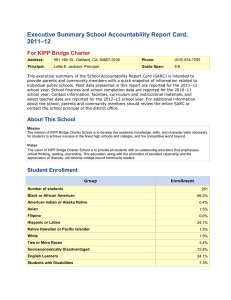School Accountability Report Card
advertisement
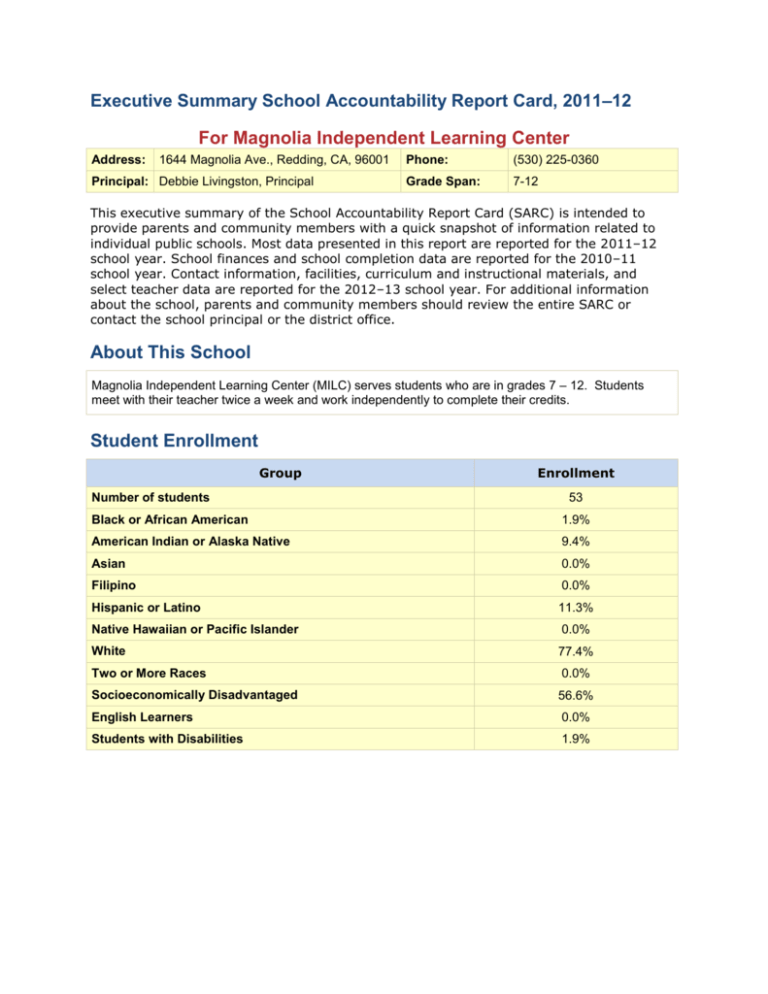
Executive Summary School Accountability Report Card, 2011–12 For Magnolia Independent Learning Center Address: 1644 Magnolia Ave., Redding, CA, 96001 Principal: Debbie Livingston, Principal Phone: (530) 225-0360 Grade Span: 7-12 This executive summary of the School Accountability Report Card (SARC) is intended to provide parents and community members with a quick snapshot of information related to individual public schools. Most data presented in this report are reported for the 2011–12 school year. School finances and school completion data are reported for the 2010–11 school year. Contact information, facilities, curriculum and instructional materials, and select teacher data are reported for the 2012–13 school year. For additional information about the school, parents and community members should review the entire SARC or contact the school principal or the district office. About This School Magnolia Independent Learning Center (MILC) serves students who are in grades 7 – 12. Students meet with their teacher twice a week and work independently to complete their credits. Student Enrollment Group Number of students Enrollment 53 Black or African American 1.9% American Indian or Alaska Native 9.4% Asian 0.0% Filipino 0.0% Hispanic or Latino 11.3% Native Hawaiian or Pacific Islander 0.0% White 77.4% Two or More Races 0.0% Socioeconomically Disadvantaged 56.6% English Learners 0.0% Students with Disabilities 1.9% Teachers Indicator Teachers Teachers with full credential 2 Teachers without full credential 0 Teachers Teaching Outside Subject Area of Competence 0 Misassignments of Teachers of English Learners 0 Total Teacher Misassignments 0 Student Performance Subject Students Proficient and Above on STAR* Program Results English-Language Arts 16% Mathematics 0% Science 7% History-Social Science 8% *Standardized Testing and Reporting Program assessments used for accountability purposes include the California Standards Tests, the California Modified Assessment, and the California Alternate Performance Assessment. Academic Progress* Indicator 2012 Growth API Score (from 2012 Growth API Report) Statewide Rank (from 2011 Base API Report) Met All 2012 AYP Requirements Number of AYP Criteria Met Out of the Total Number of Criteria Possible Result 623 1 Yes Met 4 of 4 2012–13 Program Improvement Status (PI Year) *The Academic Performance Index is required under state law. Adequate Yearly Progress is required by federal law. School Facilities Summary of Most Recent Site Inspection The Shasta County Office of Education takes great efforts to ensure that all schools are clean, safe, and functional. To assist in this effort, the Shasta County Office of Education uses a facility survey instrument developed by the State of California Office of Public School Construction. The results of this survey showed the Magnolia Independent Learning Center (MILC) in fair condition. More details are listed later in this report, and are available at the county office, or on the internet at shastacoe.org. Repairs Needed The overall condition of the MILC was fair. The inspection revealed needs including roofing, dry rot repair, and while no windows were broken, some were non-functional. Corrective Actions Taken or Planned The exterior siding that had dry rot was removed and replaced with new material. The roof is scheduled to be repaired this year. Curriculum and Instructional Materials Core Curriculum Area Pupils Who Lack Textbooks and Instructional Materials Reading/Language Arts 0 Mathematics 0 Science 0 History-Social Science 0 Foreign Language 0 Health 0 Visual and Performing Arts 0 Science Laboratory Equipment (grades 9-12) N/A School Finances Level Expenditures Per Pupil (Unrestricted Sources Only) School Site $7,548 District $11,962 State $8,323 School Completion Indicator Result Graduation Rate (if applicable) Postsecondary Preparation Measure Percent Pupils Who Completed a Career Technical Education Program and Earned a High School Diploma 0.0% Graduates Who Completed All Courses Required for University of California or California State University Admission 0.0% School Accountability Report Card Reported Using Data from the 2011–12 School Year Published During 2012–13 Every school in California is required by state law to publish a School Accountability Report Card (SARC), by February 1 of each year. The SARC contains information about the condition and performance of each California public school. For more information about SARC requirements, see the California Department of Education (CDE) SARC Web page at http://www.cde.ca.gov/ta/ac/sa/. For additional information about the school, parents and community members should contact the school principal or the district office. I. Data and Access Ed-Data Partnership Web Site Ed-Data is a partnership of the CDE, EdSource, and the Fiscal Crisis and Management Assistance Team (FCMAT) that provides extensive financial, demographic, and performance information about California’s public kindergarten through grade twelve school districts and schools. DataQuest DataQuest is an online data tool located on the CDE DataQuest Web page at http://dq.cde.ca.gov/dataquest/ that contains additional information about this school and comparisons of the school to the district, the county, and the state. Specifically, DataQuest is a dynamic system that provides reports for accountability (e.g., state Academic Performance Index [API], federal Adequate Yearly Progress [AYP]), test data, enrollment, high school graduates, dropouts, course enrollments, staffing, and data regarding English learners. Internet Access Internet access is available at public libraries and other locations that are publicly accessible (e.g., the California State Library). Access to the Internet at libraries and public locations is generally provided on a first-come, first-served basis. Other use restrictions may include the hours of operation, the length of time that a workstation may be used (depending on availability), the types of software programs available on a workstation, and the ability to print documents. II. About This School Contact Information (School Year 2012–13) School District School Name Magnolia Independent Learning Center District Name Shasta County Office of Education Street 1644 Magnolia Ave. Phone Number (530) 225-0200 City, State, Zip Redding, CA, 96001 Web Site www.shastacoe.org Phone Number (530) 225-0360 Superintendent Tom Armelino Principal Debbie Livingston, Principal E-mail Address tarmelino@shastacoe.org E-mail Address dlivingston@shastacoe.org CDS Code 45104540118992 School Description and Mission Statement (School Year 2011–12) Shasta Independent Learning center is located on the Shasta College Campus. Students meet with a teacher twice a week, and then work independently at home to earn their credits for graduation. Some students concurrently enroll at Shasta College for credits that apply to both high school and college. The mission of Shasta County Office of Education, Alternative Education is: To develop educated, socially responsible citizens. Opportunities for Parental Involvement (School Year 2011–12) Parents meet with the teacher and student upon enrollment. Some parents come in with their students for their weekly appointments, and others choose to have their students work more independently. Information about the Shasta County Office of Education programs and parental rights are distributed to parents on a yearly basis. Student Enrollment by Grade Level (School Year 2011–12) Grade Level Number of Students Grade Level Number of Students Kindergarten 0 Grade 8 0 Grade 1 0 Ungraded Elementary 0 Grade 2 0 Grade 9 1 Grade 3 0 Grade 10 8 Grade 4 0 Grade 11 14 Grade 5 0 Grade 12 30 Grade 6 0 Ungraded Secondary 0 Grade 7 0 Total Enrollment 53 Student Enrollment by Student Group (School Year 2011-12) Group Percent of Total Enrollment Black or African American 1.9% American Indian or Alaska Native 9.4% Asian 0.0% Filipino 0.0% Hispanic or Latino 11.3% Native Hawaiian or Pacific Islander 0.0% White 77.4% Two or More Races 0.0% Socioeconomically Disadvantaged 56.6% English Learners 0.0% Students with Disabilities 1.9% Average Class Size and Class Size Distribution (Secondary) Subject Avg. Class Size 2009–10 Number of Classes* 122 2332 33+ Avg. Class Size 2010–11 Number of Classes* 122 2332 33+ Avg. Class Size 2011–12 Number of Classes* 122 2332 33+ English 21 3 0 0 21 2 0 0 21 2 0 0 Mathematics 21 3 0 0 21 2 0 0 21 2 0 0 Science 21 3 0 0 21 2 0 0 21 2 0 0 Social Science 21 3 0 0 21 2 0 0 21 2 0 0 * Number of classes indicates how many classrooms fall into each size category (a range of total students per classroom). At the secondary school level, this information is reported by subject area rather than grade level. III. School Climate School Safety Plan (School Year 2011–12) MILC is located on property contiguous with Shasta County Office of Education and they are included in the Shasta County Office of Education Safety Plan. Suspensions and Expulsions Rate* School 2009–10 School 2010–11 School 2011–12 District 2009–10 Suspensions Expulsions District 2010–11 District 2011–12 0.0% 0.0% 22.5% 0.0% 0.0% 0.0% 0.0% * The rate of suspensions and expulsions is calculated by dividing the total number of incidents by the total enrollment. IV. School Facilities School Facility Conditions and Planned Improvements (School Year 2012–13) The school building and grounds are cleaned daily and maintained. The Shasta County Office of Education uses the State of California Facility Inspection Tool to evaluate the school’s facility conditions. This table displays the results of the most recently completed inspection to determine the school facility’s good repair status. This inspection was conducted in August, 2012. School Facility Good Repair Status (School Year 2012–13) Repair Status System Inspected Exemplary Good Systems: Gas Leaks, Mechanical/HVAC, Sewer X Interior: Interior Surfaces X Cleanliness: Overall Cleanliness, Pest/ Vermin Infestation X Electrical: Electrical X Restrooms/Fountains: Restrooms, Sinks/ Fountains X Safety: Fire Safety, Hazardous Materials X Fair Poor Repair Needed and Action Taken or Planned Structural: Structural Damage, Roofs X Dry rot on exterior siding was eradicated in the fall of 2012. Roof repair or replacement is planned this year. External: Playground/School Grounds, Windows/ Doors/Gates/Fences X Aging windows will be considered for repair or replacement in future deferred maintenance planning. Overall Rating Note: Cells shaded in black do not require data. X V. Teachers Teacher Credentials School 2009–10 School 2010–11 School 2011–12 District 2011–12 With Full Credential 3 2 2 23 Without Full Credential 0 0 0 1 Teaching Outside Subject Area of Competence (with full credential) 0 0 0 0 Indicator 2010–11 2011–12 2012–13 Misassignments of Teachers of English Learners 0 0 0 Total Teacher Misassignments* 0 0 0 Vacant Teacher Positions 0 0 0 Teachers Teacher Misassignments and Vacant Teacher Positions Note: “Misassignments” refers to the number of positions filled by teachers who lack legal authorization to teach that grade level, subject area, student group, etc. * Total Teacher Misassignments includes the number of Misassignments of Teachers of English Learners. Core Academic Classes Taught by Highly Qualified Teachers (School Year 2011–12) The Federal Elementary and Secondary Education Act (ESEA), also known as No Child Left Behind (NCLB), requires that core academic subjects be taught by Highly Qualified Teachers, defined as having at least a bachelor’s degree, an appropriate California teaching credential, and demonstrated core academic subject area competence. For more information, see the CDE Improving Teacher and Principal Quality Web page at: http://www.cde.ca.gov/nclb/sr/tq/ Percent of Classes In Core Academic Subjects Taught by Highly Qualified Teachers Percent of Classes In Core Academic Subjects Not Taught by Highly Qualified Teachers This School 100% 0% All Schools in District 95% 5% High-Poverty Schools in District 95% 5% Low-Poverty Schools in District 95% 5% Location of Classes Note: High-poverty schools are defined as those schools with student eligibility of approximately 40 percent or more in the free and reduced price meals program. Low-poverty schools are those with student eligibility of approximately 25 percent or less in the free and reduced price meals program. VI. Support Staff Academic Counselors and Other Support Staff (School Year 2011–12) Number of FTE* Assigned to School Title Average Number of Students per Academic Counselor Academic Counselor Counselor (Social/Behavioral or Career Development) Library Media Teacher (librarian) Contracted w/SCOE Library Media Services Staff (paraprofessional) Psychologist Social Worker Nurse Speech/Language/Hearing Specialist Resource Specialist (non-teaching) Other Note: Cells shaded in black do not require data. * One Full-Time Equivalent (FTE) equals one staff member working full-time; one FTE could also represent two staff members who each work 50 percent of full-time. VII. Curriculum and Instructional Materials Quality, Currency, Availability of Textbooks and Instructional Materials (School Year 2012–13) This section describes whether the textbooks and instructional materials used at the school are from the most recent adoption; whether there are sufficient textbooks and instruction materials for each student; and information about the school’s use of any supplemental curriculum or non-adopted textbooks or instructional materials. Year and month in which data were collected: January 2013 Core Curriculum Area Textbooks and instructional materials/year of adoption From most recent adoption? Percent students lacking own assigned copy Reading/Language Arts 0% Mathematics 0% Science 0% History-Social Science 0% Foreign Language 0% Health 0% Visual and Performing Arts 0% Science Laboratory Equipment (grades 9-12) 0% VIII. School Finances Expenditures Per Pupil and School Site Teacher Salaries (Fiscal Year 2010–11) Total Expenditures Per Pupil Expenditures Per Pupil (Supplemental / Restricted) Expenditures Per Pupil (Basic / Unrestricted) Average Teacher Salary $7,570 $22 $7,548 $67,075 District $11,962 $60,578 Percent Difference – School Site and District -52.51% 10.73% State $8,323 $67,871 Percent Difference – School Site and State -9.05% -1.17% Level School Site Note: Cells shaded in black do not require data. Supplemental/Restricted expenditures come from money whose use is controlled by law or by a donor. Money that is designated for specific purposes by the district or governing board is not considered restricted. Basic/unrestricted expenditures are from money whose use, except for general guidelines, is not controlled by law or by a donor. For detailed information on school expenditures for all districts in California, see the CDE Current Expense of Education & Per-pupil Spending Web page at http://www.cde.ca.gov/ds/fd/ec/. For information on teacher salaries for all districts in California, see the CDE Certificated Salaries & Benefits Web page at http://www.cde.ca.gov/ds/fd/cs/. To look up expenditures and salaries for a specific school district, see the EdData Web site at: http://www.ed-data.org. Types of Services Funded (Fiscal Year 2011–12) MILC provides educational services funded by ADA Teacher and Administrative Salaries (Fiscal Year 2010–11) District Amount State Average For Districts In Same Category Beginning Teacher Salary $40,417 $40,582 Mid-Range Teacher Salary $57,532 $58,876 Highest Teacher Salary $82,200 $77,129 Average Principal Salary (Elementary) $83,677 $96,092 Average Principal Salary (Middle) $83,677 $100,642 Average Principal Salary (High) $83,677 $100,642 $135,960 $134,165 40.84% 29.97% 6.88% 5.64% Category Superintendent Salary Percent of Budget for Teacher Salaries Percent of Budget for Administrative Salaries Note: For detailed information on salaries, see the CDE Certificated Salaries & Benefits Web page at http://www.cde.ca.gov/ds/fd/cs/. IX. Student Performance Standardized Testing and Reporting Program The Standardized Testing and Reporting (STAR) Program consists of several key components, including: California Standards Tests (CSTs), which include English-language arts (ELA) and mathematics in grades two through eleven; science in grades five, eight, and nine through eleven; and history-social science in grades eight, and nine through eleven. California Modified Assessment (CMA), an alternate assessment that is based on modified achievement standards in ELA for grades three through eleven; mathematics for grades three through seven, Algebra I, and Geometry; and science in grades five and eight, and Life Science in grade ten. The CMA is designed to assess those students whose disabilities preclude them from achieving grade-level proficiency on an assessment of the California content standards with or without accommodations. California Alternate Performance Assessment (CAPA), includes ELA and mathematics in grades two through eleven, and science for grades five, eight, and ten. The CAPA is given to those students with significant cognitive disabilities whose disabilities prevent them from taking either the CSTs with accommodations or modifications or the CMA with accommodations. The assessments under the STAR Program show how well students are doing in relation to the state content standards. On each of these assessments, student scores are reported as performance levels. For detailed information regarding the STAR Program results for each grade and performance level, including the percent of students not tested, see the CDE STAR Results Web site at http://star.cde.ca.gov. Standardized Testing and Reporting Results for All Students – Three-Year Comparison Percent of Students Scoring at Proficient or Advanced (meeting or exceeding the state standards) Subject School District State 2009– 2010– 2011– 2009– 2010– 2011– 2009– 2010– 2011– 10 11 12 10 11 12 10 11 12 EnglishLanguage Arts 7% 20% 16% 22% 30% 34% 52% 54% 56% Mathematics 0% 0% 0% 31% 27% 35% 48% 50% 51% Science 0% 0% 7% 22% 22% 33% 54% 57% 60% HistorySocial Science 0% 13% 8% 13% 11% 18% 44% 48% 49% Note: Scores are not shown when the number of students tested is ten or less, either because the number of students in this category is too small for statistical accuracy or to protect student privacy. Standardized Testing and Reporting Results by Student Group – Most Recent Year Percent of Students Scoring at Proficient or Advanced Group EnglishLanguage Arts Mathematics Science History- Social Science All Students in the LEA 34% 35% 33% 18% All Students at the School 16% 0% 7% 8% Male 17% 0% 0% 0% Female 14% 0% 0% 7% Black or African American 0% 0% 0% 0% American Indian or Alaska Native 0% 0% 0% 0% 0% 0% 0% 0% White 17% 0% 8% 12% Two or More Races 0% 0% 0% 0% Socioeconomically Disadvantaged 19% 0% 0% 0% 0% 0% 0% 0% Asian Filipino Hispanic or Latino Native Hawaiian or Pacific Islander English Learners Students with Disabilities Students Receiving Migrant Education Services Note: Scores are not shown when the number of students tested is ten or less, either because the number of students in this category is too small for statistical accuracy or to protect student privacy. California High School Exit Examination The California High School Exit Examination (CAHSEE) is primarily used as a graduation requirement. However, the grade ten results of this exam are also used to establish the percentages of students at three proficiency levels (not proficient, proficient, or advanced) in ELA and mathematics to compute AYP designations required by the federal ESEA, also known as NCLB. For detailed information regarding CAHSEE results, see the CDE CAHSEE Web site at http://cahsee.cde.ca.gov/. California High School Exit Examination Results for All Grade Ten Students – Three-Year Comparison (if applicable) Percent of Students Scoring at Proficient or Advanced School Subject District State 2009– 2010– 2011– 2009– 2010– 2011– 2009– 2010– 2011– 10 11 12 10 11 12 10 11 12 EnglishLanguage Arts Mathematics 9% 14% 13% 16% 54% 59% 56% 13% 11% 13% 54% 56% 58% Note: Scores are not shown when the number of students tested is ten or less, either because the number of students in this category is too small for statistical accuracy or to protect student privacy. California High School Exit Examination Grade Ten Results by Student Group – Most Recent Year English-Language Arts Group All Students in the LEA All Students at the School Mathematics Not Proficient Proficient Advanced Not Proficient Proficient Advanced 84% 9% 7% 87% 13% 0% 91% 9% 0% 91% 9% 0% Male Female Black or African American American Indian or Alaska Native Asian Filipino Hispanic or Latino Native Hawaiian or Pacific Islander White Two or More Races Socioeconomically Disadvantaged English Learners Students with Disabilities Students Receiving Migrant Education Services Note: Scores are not shown when the number of students tested is ten or less, either because the number of students in this category is too small for statistical accuracy or to protect student privacy. California Physical Fitness Test Results (School Year 2011–12) The California Physical Fitness Test (PFT) is administered to students in grades five, seven, and nine only. This table displays by grade level the percent of students meeting the fitness standards for the most recent testing period. For detailed information regarding this test, and comparisons of a school’s test results to the district and state, see the CDE PFT Web page at http://www.cde.ca.gov/ta/tg/pf/. Grade Level Percent of Students Meeting Fitness Standards Four of Six Standards Five of Six Standards Six of Six Standards 5 N/A N/A N/A 7 N/A N/A N/A 9 Note: Scores are not shown when the number of students tested is ten or less, either because the number of students in this category is too small for statistical accuracy or to protect student privacy. X. Accountability Academic Performance Index The Academic Performance Index (API) is an annual measure of state academic performance and progress of schools in California. API scores range from 200 to 1,000, with a statewide target of 800. For detailed information about the API, see the CDE API Web page at http://www.cde.ca.gov/ta/ac/ap/. Academic Performance Index Ranks – Three-Year Comparison This table displays the school’s statewide and similar schools’ API ranks. The statewide API rank ranges from 1 to 10. A statewide rank of 1 means that the school has an API score in the lowest ten percent of all schools in the state, while a statewide rank of 10 means that the school has an API score in the highest ten percent of all schools in the state. The similar schools API rank reflects how a school compares to 100 statistically matched “similar schools.” A similar schools rank of 1 means that the school’s academic performance is comparable to the lowest performing ten schools of the 100 similar schools, while a similar schools rank of 10 means that the school’s academic performance is better than at least 90 of the 100 similar schools. API Rank Statewide Similar Schools 2009 2010 2011 1 Academic Performance Index Growth by Student Group – Three-Year Comparison Group Actual API Change 2009–10 Actual API Change 2010–11 Actual API Change 2011–12 B 130 All Students at the School Black or African American American Indian or Alaska Native Asian Filipino Hispanic or Latino Native Hawaiian or Pacific Islander White Two or More Races Socioeconomically Disadvantaged English Learners Students with Disabilities Note: “N/D” means that no data were available to the CDE or LEA to report. “B” means the school did not have a valid API Base and there is no Growth or target information. “C” means the school had significant demographic changes and there is no Growth or target information. Academic Performance Index Growth by Student Group – 2012 Growth API Comparison This table displays, by student group, the number of students included in the API and the 2012 Growth API at the school, LEA, and state level. 2012 Growth API Group Number of Students School Number of Students LEA Number of Students State All Students at the School 18 623 73 507 4,664,264 788 Black or African American 0 2 313,201 710 American Indian or Alaska Native 0 2 31,606 742 Asian 0 1 404,670 905 Filipino 0 0 124,824 869 Hispanic or Latino 1 12 2,425,230 740 Native Hawaiian or Pacific Islander 0 0 26,563 775 White 16 1,221,860 853 Two or More Races 1 88,428 849 Socioeconomically Disadvantaged 11 2,779,680 737 English Learners 0 0 1,530,297 716 Students with Disabilities 0 8 530,935 607 612 52 399 541 4 650 56 497 Adequate Yearly Progress The federal ESEA requires that all schools and districts meet the following Adequate Yearly Progress (AYP) criteria: Participation rate on the state’s standards-based assessments in ELA and mathematics Percent proficient on the state’s standards-based assessments in ELA and mathematics API as an additional indicator Graduation rate (for secondary schools) For detailed information about AYP, including participation rates and percent proficient results by student group, see the CDE AYP Web page at http://www.cde.ca.gov/ta/ac/ay/. Adequate Yearly Progress Overall and by Criteria (School Year 2011–12) AYP Criteria School District Made AYP Overall Yes No Met Participation Rate - English-Language Arts Yes Yes Met Participation Rate - Mathematics Yes Yes Met Percent Proficient - English-Language Arts Yes No Met Percent Proficient - Mathematics Yes No Met API Criteria N/A Yes Met Graduation Rate N/A Yes Federal Intervention Program (School Year 2012–13) Schools and districts receiving federal Title I funding enter Program Improvement (PI) if they do not make AYP for two consecutive years in the same content area (ELA or mathematics) or on the same indicator (API or graduation rate). After entering PI, schools and districts advance to the next level of intervention with each additional year that they do not make AYP. For detailed information about PI identification, see the CDE PI Status Determinations Web page: http://www.cde.ca.gov/ta/ac/ay/tidetermine.asp. Indicator Program Improvement Status First Year of Program Improvement Year in Program Improvement School District In PI 2010-2011 Year 3 Number of Schools Currently in Program Improvement 1 Percent of Schools Currently in Program Improvement 16.7% Note: Cells shaded in black do not require data. XI. School Completion and Postsecondary Preparation Admission Requirements for California’s Public Universities University of California Admission requirements for the University of California (UC) follow guidelines set forth in the Master Plan, which requires that the top one-eighth of the state’s high school graduates, as well as those transfer students who have successfully completed specified college course work, be eligible for admission to the UC. These requirements are designed to ensure that all eligible students are adequately prepared for University-level work. For general admissions requirements, please visit the UC Admissions Information Web page at http://www.universityofcalifornia.edu/admissions/. (Outside source) California State University Eligibility for admission to the California State University (CSU) is determined by three factors: Specific high school courses Grades in specified courses and test scores Graduation from high school Some campuses have higher standards for particular majors or students who live outside the local campus area. Because of the number of students who apply, a few campuses have higher standards (supplementary admission criteria) for all applicants. Most CSU campuses have local admission guarantee policies for students who graduate or transfer from high schools and colleges that are historically served by a CSU campus in that region. For admission, application, and fee information see the CSU Web page at http://www.calstate.edu/admission/admission.shtml. (Outside source) Dropout Rate and Graduation Rate School District State Indicator 2008– 2009– 2010– 2008– 2009– 2010– 2008– 2009– 2010– 09 10 11 09 10 11 09 10 11 Dropout Rate 12.8 Graduation Rate 46.1 12.1 Note: Cells shaded in black do not require data. 12.8 12.1 16.6 14.4 83.38 84.30 74.72 76.26 Completion of High School Graduation Requirements This table displays, by student group, the percent of students who began the 2011–12 school year in grade twelve and were a part of the school’s most recent graduating class, meeting all state and local graduation requirements for grade twelve completion, including having passed both the ELA and mathematics portions of the CAHSEE or received a local waiver or state exemption. Group Graduating Class of 2012 School District State All Students N/D Black or African American N/D American Indian or Alaska Native N/D Asian N/D Filipino N/D Hispanic or Latino N/D Native Hawaiian or Pacific Islander N/D White N/D Two or More Races N/D Socioeconomically Disadvantaged N/D English Learners N/D Students with Disabilities N/D Note: “N/D” means that no data were available to the CDE or LEA to report. Career Technical Education Programs (School Year 2011–12) MILC does not provide any Career Technical Education programs. Some MILC students enroll in Shasta Trinity Regional Occupational Programs. Career Technical Education Participation (School Year 2011–12) Measure CTE Program Participation Number of pupils participating in CTE 0 Percent of pupils completing a CTE program and earning a high school diploma 0 Percent of CTE courses sequenced or articulated between the school and institutions of postsecondary education 0 Courses for University of California and/or California State University Admission UC/CSU Course Measure Percent 2011-12 Students Enrolled in Courses Required for UC/CSU Admission 0.0% 2010-11 Graduates Who Completed All Courses Required for UC/CSU Admission 0.0% Advanced Placement Courses (School Year 2011–12) Subject Number of AP Courses Offered* Computer Science 0 English 0 Fine and Performing Arts 0 Foreign Language 0 Mathematics 0 Science 0 Social Science 0 All courses 0 Percent of Students In AP Courses 0.0% Note: Cells shaded in black do not require data. *Where there are student course enrollments. XII. Instructional Planning and Scheduling Professional Development This section provides information on the annual number of school days dedicated to staff development for the most recent three-year period. Teachers have three staff development days per year. In addition the independent study teachers meet twice monthly for collaboration. Magnolia Independent Learning Center Shasta County Office of Education School Accountability Report Card, 2011-2012 Provided by the Ed-Data Partnership For more information visit www.ed-data.org
